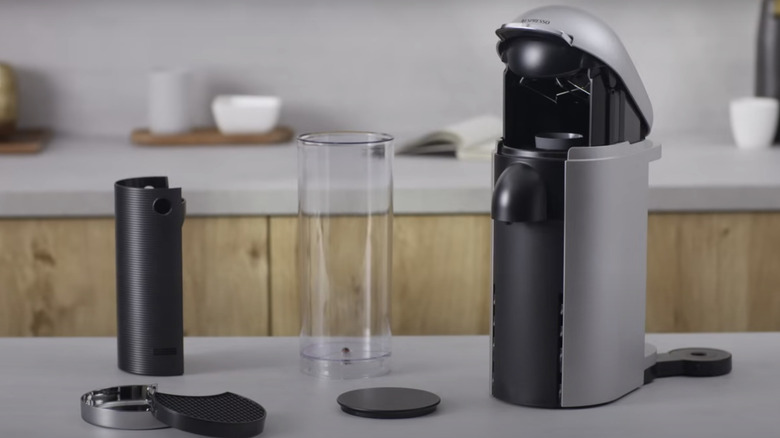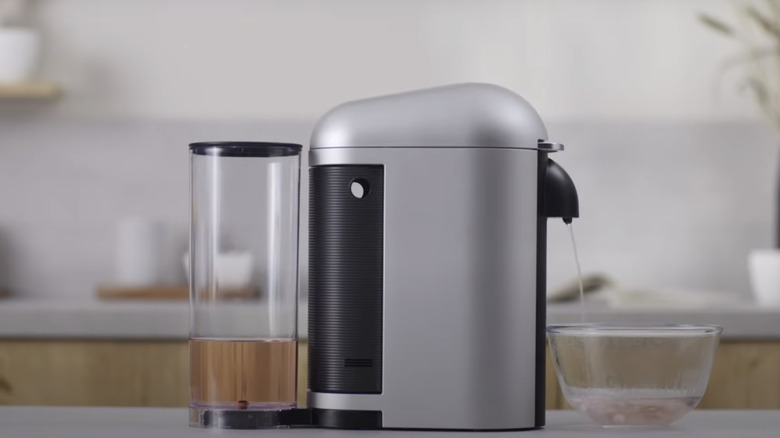The Best Way To Deep Clean Your Nespresso Coffee Maker (& One Mistake To Avoid)
Nespresso machines completely transformed the way that many of us make coffee at home — what used to be drip coffee that had us longing for a Starbucks latte is now fresh and foamy espresso we can't get enough of. But our Nespresso machines need routine upkeep and cleaning (like all small kitchen appliances do) to continue running efficiently and producing delicious java. This process includes cleaning all the machine's components with hot, soapy water, running the machine's cleaning cycle, and descaling it for good measure. But, no matter what you do, it's essential not to run other chemicals like vinegar through your machine.
You should deep clean and descale your Nespresso machine once every 300 capsules or one to two times a year if you use it less frequently. Falling behind on a cleaning schedule will cause problems for your machine down the line, shortening the overall lifespan of your espresso maker, allowing buildup and residue to linger, and producing coffee that doesn't taste quite right. It is important to note that a deep clean and a descaling process are two separate actions, and for the best results, you should aim to complete both. Different models will have various ways of activating the cleaning and descaling cycles, where the machine runs water and descaling solution for five to 15 minutes to flush out bacteria and buildup, so be sure to research your model online or double-check your owner's manual before beginning.
Deep cleaning and descaling
Deep cleaning and descaling your Nespresso machine is essential to its overall lifespan and the delectable taste it produces for each pod of espresso it brews. While deep cleaning and descaling go hand in hand and are often performed together, they are two different processes to put your machine through. First will be an extensive cleanse of your entire machine — inside and out. Depending on the model you own, begin by removing each appliance component, including the water tank, drip tray, capsule container, and steam wand. Gently clean the machine's pieces with hot water and soap, avoiding submerging where you can and running them through the dishwasher. After rinsing thoroughly, you can reassemble your machine and begin running the basic cleaning cycle with just water.
Descaling your Nespresso machine involves a process similar to the water-run cleaning cycle but with the use of a specialized solution to remove limescale build-up. Limescale, a white, chalk-like residue that forms after water evaporation, can affect the taste of your espresso. While commonly found on sinks and showers, it can also afflict your Nespresso machine. Nespresso offers descaling kits for $19.50 on their website, each containing two, 100ml packets of their descaling solution. It's crucial to use only approved chemicals and follow the instructions on the descaling solution packaging to ensure the safety and effectiveness of the descaling process. Place at least a 4-cup container under the spout for both cycles to catch and discard the water waste.
Signs to look for
The frequency at which your Nespresso machine needs deep cleaned and descaled varies depending on how often it's used. For daily coffee drinkers, it's good practice to perform a water flush weekly and a daily wipe down to remove hard water stains, outside calcium buildup, and espresso splatter residue. But knowing when your machine is due for a deep clean and descaling takes more attention. While you can count up to 300 capsules or time it once every six months, it will also be beneficial to know some of the tell-tale signs that your Nespresso machine is begging for that deeper clean and descaling.
Many Nespresso models are programmed to let you know when a descaling is needed, so always check your owner's manual. However, even without the machine giving a warning, you can still identify when it's time by simply observing. If you notice that your machine is slower to brew and making uncommon noises, this is always a crucial sign that something is wrong. But your coffee will also be affected, and you'll notice the espresso is not getting as hot as it should be and has a more bitter aftertaste than what you're used to. While digesting limescale isn't harmful, it's certainly not appealing to our palettes. A routine deep clean and descale is easy to keep pushing off, but taking the time to get it done will result in your morning lattes, afternoon coffees, and nightly cappuccinos tasting better than ever.


